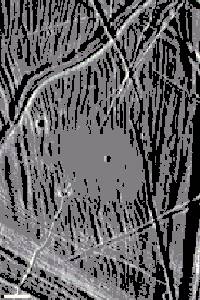9 December 1998
Liquid Oceans On Europa?

Europa looks something like a cracked cue ball (pictured). The possibility that a liquid water ocean may lurk beneath its ice crust was first raised at the time of the Voyager missions in the late 1970s, but was reinforced in 1996 when images of Europa's surface were beamed to Earth by the Galileo spacecraft. The images showed areas where the surface ice has been broken up and shifted around like pieces of a jigsaw puzzle, leading Ronald Greeley from Arizona State University to propose that the Europan icebergs must be lubricated from below by warm ice or liquid water.
Christopher Chyba, from the SETI Institute, summarized the current evidence for an ocean on Europa;
- In addition to the iceberg-like areas, Galileo imagery has revealed an impact crater that appears to have been filled in at the bottom, areas that appear to show localized melting near the surface, and other features consistent with a liquid layer below the ice;
- Galileo's onboard magnetometer, which measures magnetic fields, has measured fluctuations that are consistent with the magnetic effects of currents flowing in a salty ocean;
- Lack of cratering on Europa's surface indicates that it is very young -- less than 10 million years -- which suggests that it is being continually resurfaced, possibly by frost falling from liquid water geysers encountering Europa's frigid surface temperatures, which hover at -170 degrees Celsius;
- Theoretical estimates of the amount of heat produced by the gravitational push and pull exerted on Europa by the other Jovian moons indicate that it should be adequate to warm the moon's interior enough to sustain a liquid ocean.
"All these lines of evidence point to a liquid water ocean," Chyba said.
Europa Orbiter, a NASA mission in the early planning stages, that is scheduled for launch in 2003, is being designed specifically to look for evidence of a Europan ocean. The investigations that the science definition team has suggested for the proposed $250 million Europa Orbiter include imaging, altimetry, gravity measurements and subsurface radar soundings.
"The most decisive measurements are likely to come from the altimetry and gravity measurements," Chyba said. As Europa travels in a slightly eccentric orbit around Jupiter, tides are raised, similar to the lunar tides on Earth. If the distant satellite contains a deep ocean covered by the thin ice crust, then the tidal movements should be fairly large, producing a 30-meter rise and fall each 3.5 days. But if the moon is solid ice the deformation would be only a meter or so. The altimeter and gravity measurements independently would measure this effect.
"If the orbiter confirms that Europa has a liquid ocean, then it will become one of hottest places in the solar system, along with Mars, to search for life. In this case there will be an entire program of exploration, likely involving a series of spacecraft to Europa." But if the Moon does not conceal such an ocean, then it will move down significantly on the space agency's priority list, he said.
Pic Courtesy NASA
